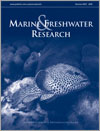Marine and Freshwater Research
Volume 69
Number 2 2018
Eels have been remotely tracked in their freshwater, brackish and marine habitats for five decades to understand the extent of their migrations and to ensure the conservation of these enigmatic species. Herein we review 105 studies that tracked eels and summarise findings relative to the species, life history stages and habitats studied. In addition, we discuss the need for continued development of telemetry technology and future research directions in eel biology.
Copepod species diversity along the southern coastline of Sfax, Tunisia, depends on anthropogenic inputs. Oithona nana, Paracalanus parvus, Harpacticus littoralis and Tisbe battagliai were spread along the coast and were more adapted to coastal anthropogenic inputs. The Shannon–Wiener index, H′, was higher in the southern, less affected, stations than in the northern stations, which were affected by sewage to a greater extent.
This study assesses the effect of reintroducing large wood on fish assemblages along the Barwon-Darling River, Australia. Results demonstrate that reintroducing large wood had limited influence on fish. It is hypothesised the lack of a detectable response by fish was because the physical character and position of the reintroduced wood pieces didn’t replicate ‘natural’ reference conditions.
The roles of environment and space in stream fish assemblages were evaluated in distinct hydrological periods in the eastern Amazon. The results indicate that spatial and environmental factors play complementary roles, and that diversity was affected by changes in the habitat connectivity experienced in different hydrological periods.
A large flood (436.6 m3 s–1) that occurred in the freshwater-deprived Kariega Estuary resulted in a normal longitudinal salinity gradient being present throughout the study period (December 2013–November 2014). This resulted in an increase in the abundance of early juvenile estuarine-associated marine fish, particularly in the middle and upper reaches, which was linked to an increase in nutrients and food availability, as well as increased nursery habitats.
Hypoxia can profoundly affect fish reproduction and larval development, but its effects on fish from tropical Australia are not well understood. In the study, the effects of diel fluctuating hypoxia on reproduction were identified for a range-limited tropical freshwater fish. Utchee Creek rainbowfish appear to be more hypoxia tolerant than many temperate species, but are still susceptible to the increasing frequency and intensity of hypoxia that may occur as a result of climate change.
Rezoning of Moreton Bay Marine Park increased the no-take area from 0.5 to 16%, incorporating 10% of each major habitat type. Displacement of fishing effort was 6.3%, demonstrating that science-based conservation and community consultation can protect biodiverse habitats, while maintaining existing uses of a marine park. However, achieving biodiversity conservation must rely on ensuring no-take zones adequately represent ecological processes.
The present study is the first to investigate the bacterial communities associated with the harmful dinoflagellate Prorocentrum minimum using a pyrosequencing assay. Throughout the study, particle-associated (PA) and free-living (FL) bacterial communities were significantly associated with the growth phases of P. minimum. Although the FL and PA bacterial communities differed significantly, Roseobacter and Marinobacter clades showed a close association with the growth of P. minimum in both communities.
The rock hind is a medium-sized Atlantic reef grouper exploited by fisheries; it represents an important resource for small and medium-scale fisheries along the coast of Brazil. This study reports on the pattern of sexual development and demography of a protogynous species on the north-east coast of Brazil. A lack of fisheries management endangers the future sustainability of fisheries for this and other hermaphroditic species of groupers that otherwise may suffer declines similar to those observed for larger species.
In this study, 63 cases of deformities were reported from 23 fish species collected from five countries. The observed abnormalities are discussed within the framework of contaminated aquatic environments, with a goal of recognising the cause of abnormality. There were 52 cases of slight and 9 of severe scale anomalies. The results of this study should assist in future work on the environmental condition.
Pristipomoides filamentosus, a long-lived deep-water eteline snapper, is an economically important component of commercial and recreational fisheries throughout much of the Indo-Pacific region. This study provides the first sex-specific, histologically validated estimates of size at maturity for P. filamentosus in the Main Hawaiian Islands or elsewhere. Estimates are compared with those previously derived for the species using non-histological methods, and suggestions for re-evaluating minimum legal size regulations for fisheries of the species in Hawaii are included.
This is the first study to investigate mucus as a potential new and useful material in elasmobranch dietary studies using stable isotope analysis. Mucus collected from giant manta rays was indicative of a broader short-term diet during aggregation periods in Ecuador, in comparison to muscle, which suggested long-term diet is more conservative. Both mucus and muscle support that giant manta rays predominately feed on zooplankton at a secondary consumer trophic level.




